Total Reward Systems: Motivation Techniques in Different Sectors
VerifiedAdded on 2020/06/05
|11
|3406
|59
Essay
AI Summary
This essay delves into the concept of total reward systems as a critical tool for motivating employees in contemporary organizations. It begins by defining total reward systems and connecting them with established motivational theories, including Maslow's Hierarchy of Needs and Herzberg's Two-Factor Theory. The essay then applies these concepts to two distinct employment sectors: retail and hospitality. It provides a comparative analysis of how total reward systems are implemented in these sectors, using the examples of Tesco (retail) and Hilton Hotel (hospitality) to illustrate practical applications. The analysis covers various aspects of reward systems, including compensation, benefits, work-life effectiveness, recognition, performance management, and talent development. Both financial and non-financial rewards are considered, highlighting their importance in enhancing employee engagement, reducing turnover, and improving overall organizational performance. The essay emphasizes the link between reward strategies and motivational theories, demonstrating how rewards can satisfy employee needs and drive better work outcomes.
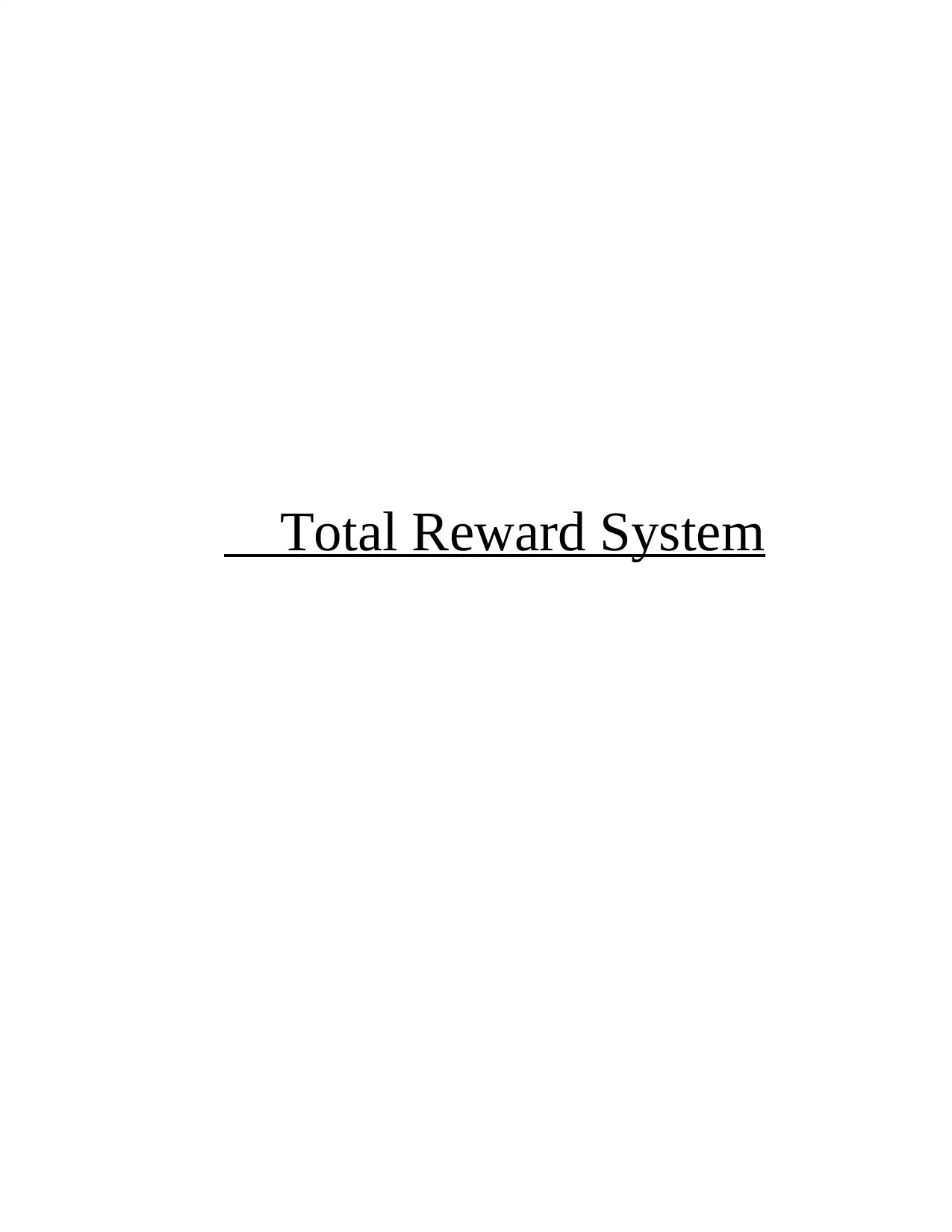
Total Reward System
Paraphrase This Document
Need a fresh take? Get an instant paraphrase of this document with our AI Paraphraser
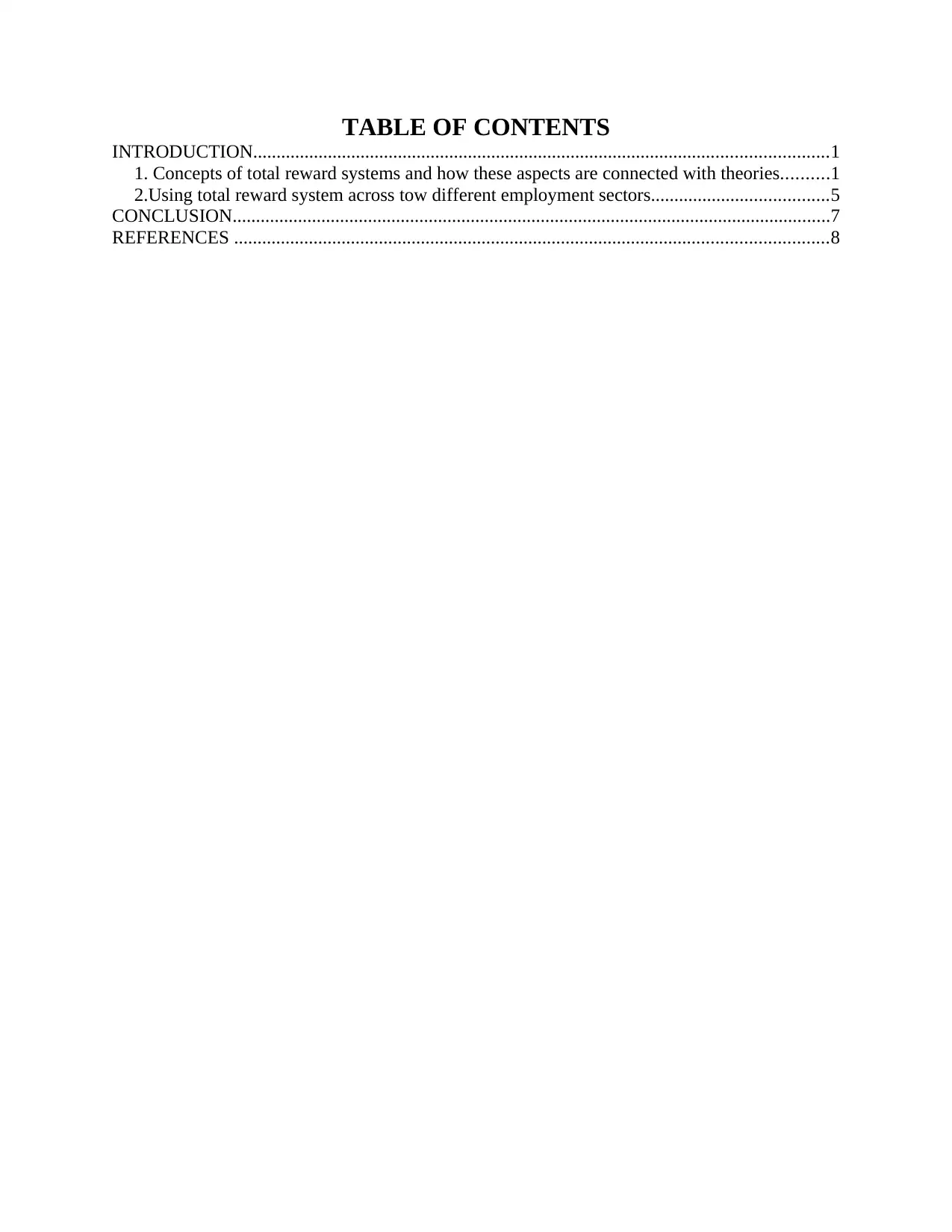
TABLE OF CONTENTS
INTRODUCTION...........................................................................................................................1
1. Concepts of total reward systems and how these aspects are connected with theories..........1
2.Using total reward system across tow different employment sectors......................................5
CONCLUSION................................................................................................................................7
REFERENCES ...............................................................................................................................8
INTRODUCTION...........................................................................................................................1
1. Concepts of total reward systems and how these aspects are connected with theories..........1
2.Using total reward system across tow different employment sectors......................................5
CONCLUSION................................................................................................................................7
REFERENCES ...............................................................................................................................8
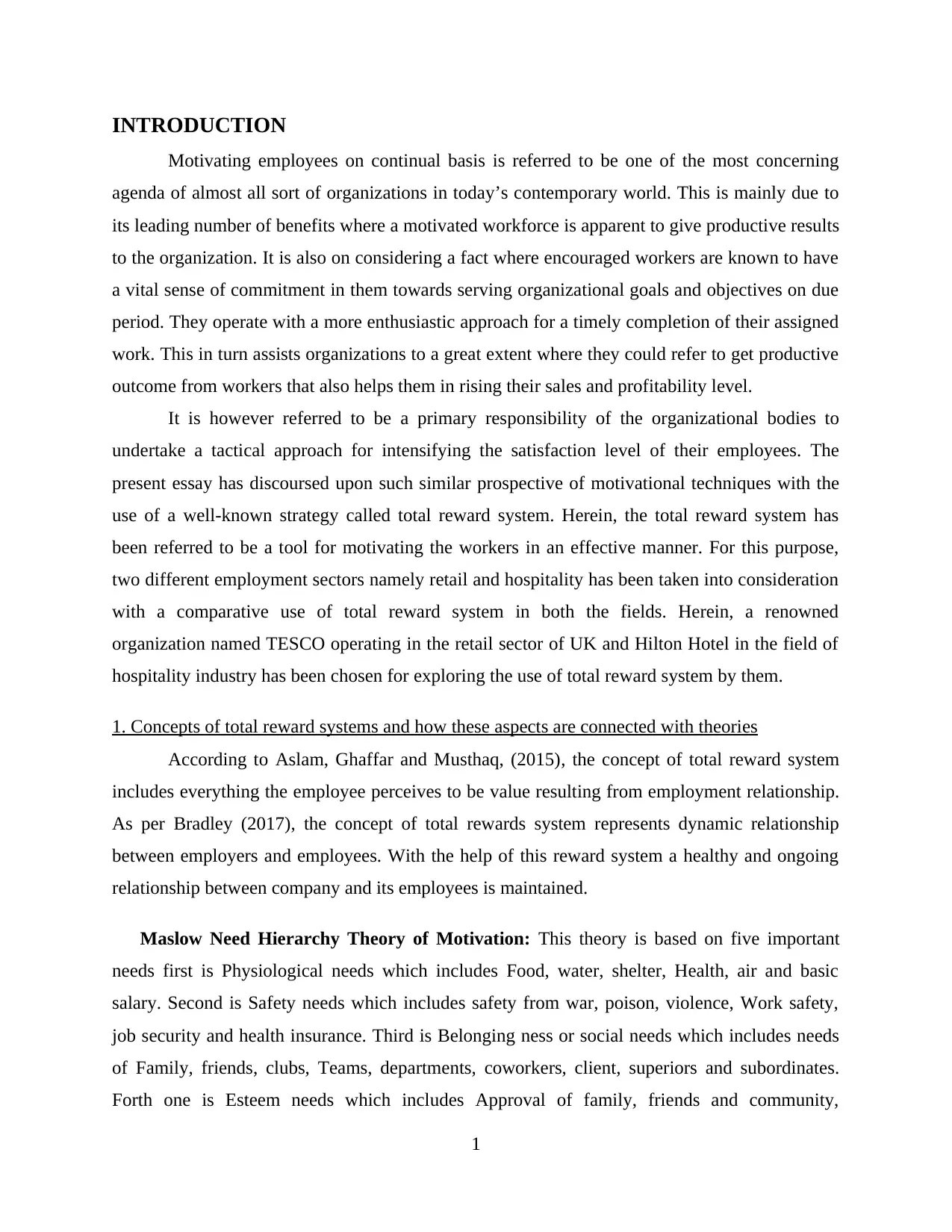
INTRODUCTION
Motivating employees on continual basis is referred to be one of the most concerning
agenda of almost all sort of organizations in today’s contemporary world. This is mainly due to
its leading number of benefits where a motivated workforce is apparent to give productive results
to the organization. It is also on considering a fact where encouraged workers are known to have
a vital sense of commitment in them towards serving organizational goals and objectives on due
period. They operate with a more enthusiastic approach for a timely completion of their assigned
work. This in turn assists organizations to a great extent where they could refer to get productive
outcome from workers that also helps them in rising their sales and profitability level.
It is however referred to be a primary responsibility of the organizational bodies to
undertake a tactical approach for intensifying the satisfaction level of their employees. The
present essay has discoursed upon such similar prospective of motivational techniques with the
use of a well-known strategy called total reward system. Herein, the total reward system has
been referred to be a tool for motivating the workers in an effective manner. For this purpose,
two different employment sectors namely retail and hospitality has been taken into consideration
with a comparative use of total reward system in both the fields. Herein, a renowned
organization named TESCO operating in the retail sector of UK and Hilton Hotel in the field of
hospitality industry has been chosen for exploring the use of total reward system by them.
1. Concepts of total reward systems and how these aspects are connected with theories
According to Aslam, Ghaffar and Musthaq, (2015), the concept of total reward system
includes everything the employee perceives to be value resulting from employment relationship.
As per Bradley (2017), the concept of total rewards system represents dynamic relationship
between employers and employees. With the help of this reward system a healthy and ongoing
relationship between company and its employees is maintained.
Maslow Need Hierarchy Theory of Motivation: This theory is based on five important
needs first is Physiological needs which includes Food, water, shelter, Health, air and basic
salary. Second is Safety needs which includes safety from war, poison, violence, Work safety,
job security and health insurance. Third is Belonging ness or social needs which includes needs
of Family, friends, clubs, Teams, departments, coworkers, client, superiors and subordinates.
Forth one is Esteem needs which includes Approval of family, friends and community,
1
Motivating employees on continual basis is referred to be one of the most concerning
agenda of almost all sort of organizations in today’s contemporary world. This is mainly due to
its leading number of benefits where a motivated workforce is apparent to give productive results
to the organization. It is also on considering a fact where encouraged workers are known to have
a vital sense of commitment in them towards serving organizational goals and objectives on due
period. They operate with a more enthusiastic approach for a timely completion of their assigned
work. This in turn assists organizations to a great extent where they could refer to get productive
outcome from workers that also helps them in rising their sales and profitability level.
It is however referred to be a primary responsibility of the organizational bodies to
undertake a tactical approach for intensifying the satisfaction level of their employees. The
present essay has discoursed upon such similar prospective of motivational techniques with the
use of a well-known strategy called total reward system. Herein, the total reward system has
been referred to be a tool for motivating the workers in an effective manner. For this purpose,
two different employment sectors namely retail and hospitality has been taken into consideration
with a comparative use of total reward system in both the fields. Herein, a renowned
organization named TESCO operating in the retail sector of UK and Hilton Hotel in the field of
hospitality industry has been chosen for exploring the use of total reward system by them.
1. Concepts of total reward systems and how these aspects are connected with theories
According to Aslam, Ghaffar and Musthaq, (2015), the concept of total reward system
includes everything the employee perceives to be value resulting from employment relationship.
As per Bradley (2017), the concept of total rewards system represents dynamic relationship
between employers and employees. With the help of this reward system a healthy and ongoing
relationship between company and its employees is maintained.
Maslow Need Hierarchy Theory of Motivation: This theory is based on five important
needs first is Physiological needs which includes Food, water, shelter, Health, air and basic
salary. Second is Safety needs which includes safety from war, poison, violence, Work safety,
job security and health insurance. Third is Belonging ness or social needs which includes needs
of Family, friends, clubs, Teams, departments, coworkers, client, superiors and subordinates.
Forth one is Esteem needs which includes Approval of family, friends and community,
1
⊘ This is a preview!⊘
Do you want full access?
Subscribe today to unlock all pages.

Trusted by 1+ million students worldwide
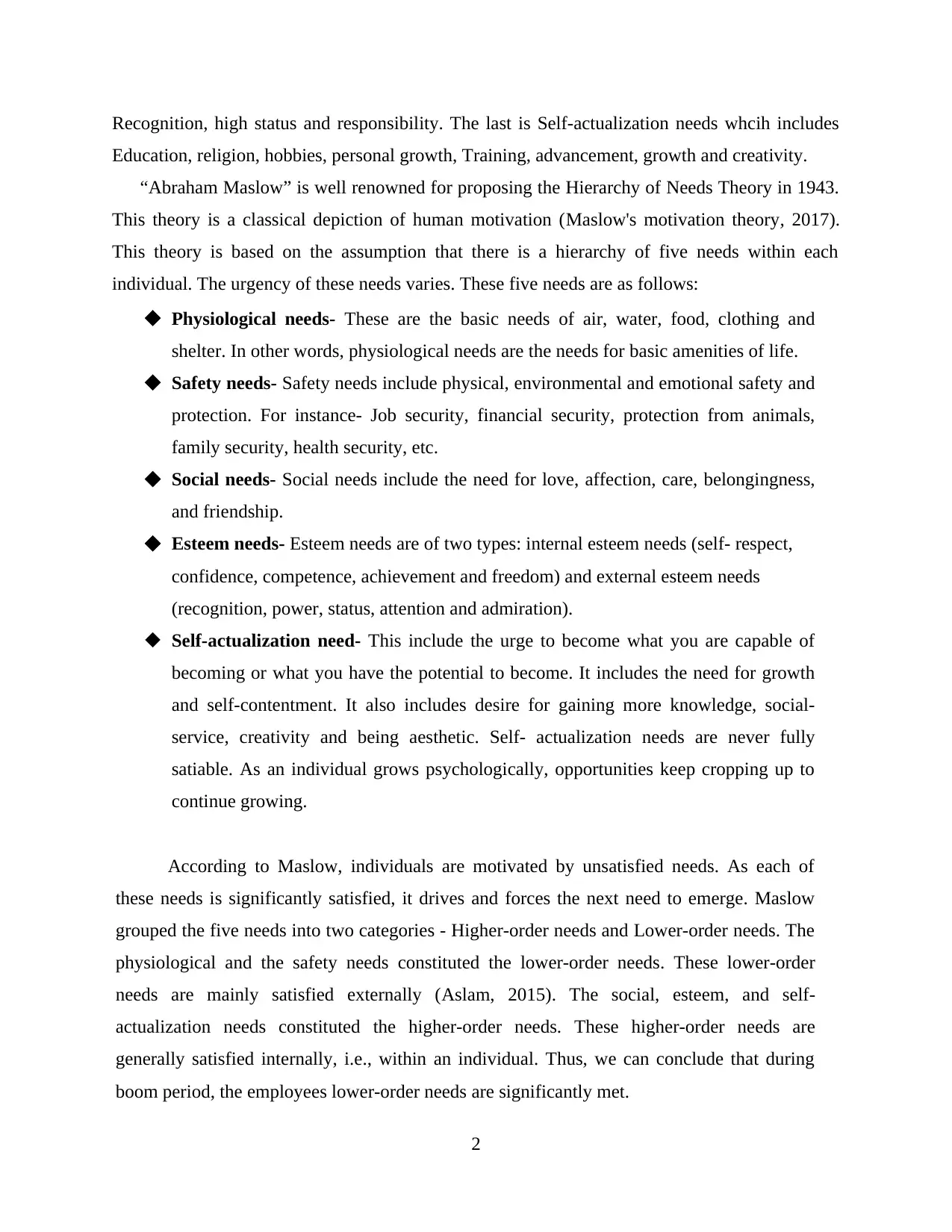
Recognition, high status and responsibility. The last is Self-actualization needs whcih includes
Education, religion, hobbies, personal growth, Training, advancement, growth and creativity.
“Abraham Maslow” is well renowned for proposing the Hierarchy of Needs Theory in 1943.
This theory is a classical depiction of human motivation (Maslow's motivation theory, 2017).
This theory is based on the assumption that there is a hierarchy of five needs within each
individual. The urgency of these needs varies. These five needs are as follows:
Physiological needs- These are the basic needs of air, water, food, clothing and
shelter. In other words, physiological needs are the needs for basic amenities of life.
Safety needs- Safety needs include physical, environmental and emotional safety and
protection. For instance- Job security, financial security, protection from animals,
family security, health security, etc.
Social needs- Social needs include the need for love, affection, care, belongingness,
and friendship.
Esteem needs- Esteem needs are of two types: internal esteem needs (self- respect,
confidence, competence, achievement and freedom) and external esteem needs
(recognition, power, status, attention and admiration).
Self-actualization need- This include the urge to become what you are capable of
becoming or what you have the potential to become. It includes the need for growth
and self-contentment. It also includes desire for gaining more knowledge, social-
service, creativity and being aesthetic. Self- actualization needs are never fully
satiable. As an individual grows psychologically, opportunities keep cropping up to
continue growing.
According to Maslow, individuals are motivated by unsatisfied needs. As each of
these needs is significantly satisfied, it drives and forces the next need to emerge. Maslow
grouped the five needs into two categories - Higher-order needs and Lower-order needs. The
physiological and the safety needs constituted the lower-order needs. These lower-order
needs are mainly satisfied externally (Aslam, 2015). The social, esteem, and self-
actualization needs constituted the higher-order needs. These higher-order needs are
generally satisfied internally, i.e., within an individual. Thus, we can conclude that during
boom period, the employees lower-order needs are significantly met.
2
Education, religion, hobbies, personal growth, Training, advancement, growth and creativity.
“Abraham Maslow” is well renowned for proposing the Hierarchy of Needs Theory in 1943.
This theory is a classical depiction of human motivation (Maslow's motivation theory, 2017).
This theory is based on the assumption that there is a hierarchy of five needs within each
individual. The urgency of these needs varies. These five needs are as follows:
Physiological needs- These are the basic needs of air, water, food, clothing and
shelter. In other words, physiological needs are the needs for basic amenities of life.
Safety needs- Safety needs include physical, environmental and emotional safety and
protection. For instance- Job security, financial security, protection from animals,
family security, health security, etc.
Social needs- Social needs include the need for love, affection, care, belongingness,
and friendship.
Esteem needs- Esteem needs are of two types: internal esteem needs (self- respect,
confidence, competence, achievement and freedom) and external esteem needs
(recognition, power, status, attention and admiration).
Self-actualization need- This include the urge to become what you are capable of
becoming or what you have the potential to become. It includes the need for growth
and self-contentment. It also includes desire for gaining more knowledge, social-
service, creativity and being aesthetic. Self- actualization needs are never fully
satiable. As an individual grows psychologically, opportunities keep cropping up to
continue growing.
According to Maslow, individuals are motivated by unsatisfied needs. As each of
these needs is significantly satisfied, it drives and forces the next need to emerge. Maslow
grouped the five needs into two categories - Higher-order needs and Lower-order needs. The
physiological and the safety needs constituted the lower-order needs. These lower-order
needs are mainly satisfied externally (Aslam, 2015). The social, esteem, and self-
actualization needs constituted the higher-order needs. These higher-order needs are
generally satisfied internally, i.e., within an individual. Thus, we can conclude that during
boom period, the employees lower-order needs are significantly met.
2
Paraphrase This Document
Need a fresh take? Get an instant paraphrase of this document with our AI Paraphraser
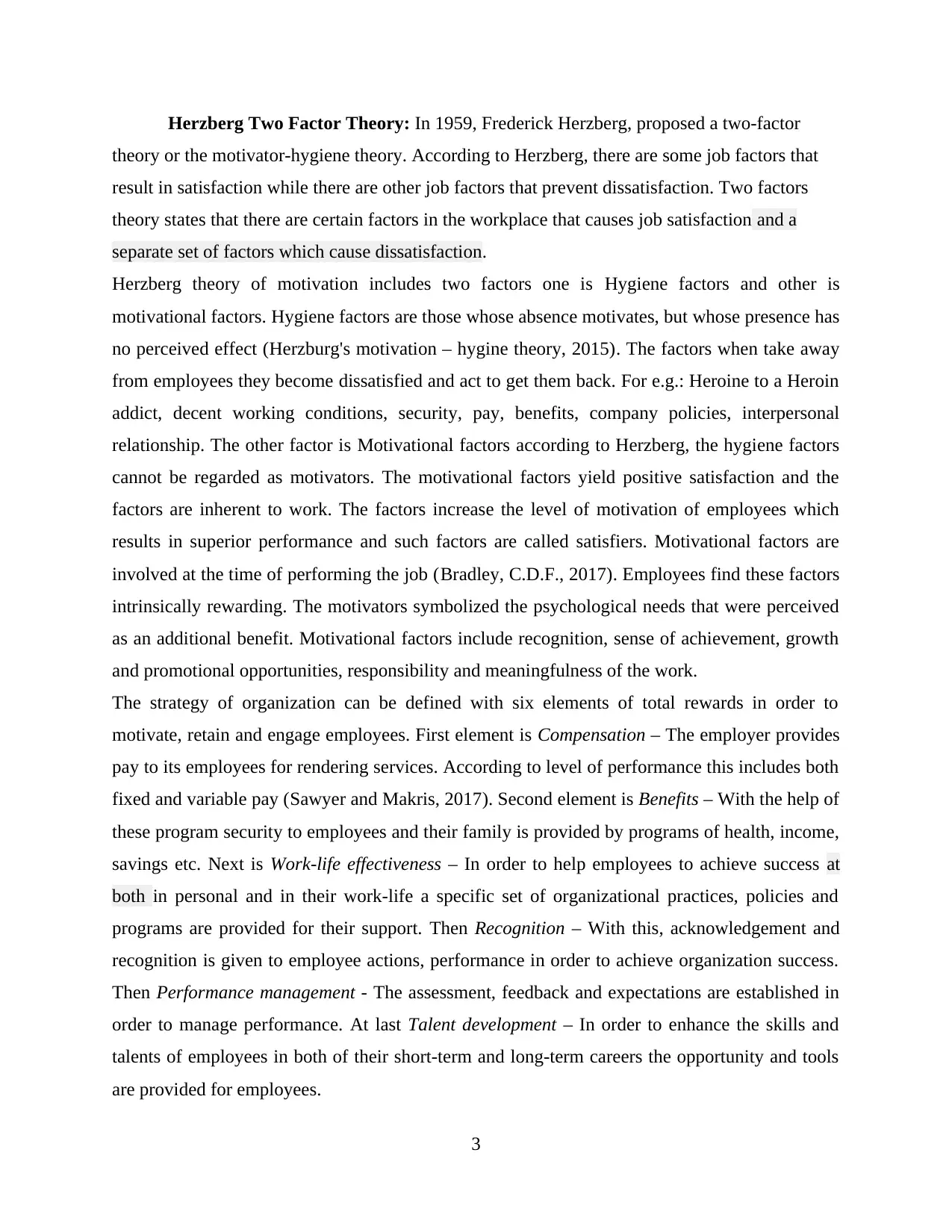
Herzberg Two Factor Theory: In 1959, Frederick Herzberg, proposed a two-factor
theory or the motivator-hygiene theory. According to Herzberg, there are some job factors that
result in satisfaction while there are other job factors that prevent dissatisfaction. Two factors
theory states that there are certain factors in the workplace that causes job satisfaction and a
separate set of factors which cause dissatisfaction.
Herzberg theory of motivation includes two factors one is Hygiene factors and other is
motivational factors. Hygiene factors are those whose absence motivates, but whose presence has
no perceived effect (Herzburg's motivation – hygine theory, 2015). The factors when take away
from employees they become dissatisfied and act to get them back. For e.g.: Heroine to a Heroin
addict, decent working conditions, security, pay, benefits, company policies, interpersonal
relationship. The other factor is Motivational factors according to Herzberg, the hygiene factors
cannot be regarded as motivators. The motivational factors yield positive satisfaction and the
factors are inherent to work. The factors increase the level of motivation of employees which
results in superior performance and such factors are called satisfiers. Motivational factors are
involved at the time of performing the job (Bradley, C.D.F., 2017). Employees find these factors
intrinsically rewarding. The motivators symbolized the psychological needs that were perceived
as an additional benefit. Motivational factors include recognition, sense of achievement, growth
and promotional opportunities, responsibility and meaningfulness of the work.
The strategy of organization can be defined with six elements of total rewards in order to
motivate, retain and engage employees. First element is Compensation – The employer provides
pay to its employees for rendering services. According to level of performance this includes both
fixed and variable pay (Sawyer and Makris, 2017). Second element is Benefits – With the help of
these program security to employees and their family is provided by programs of health, income,
savings etc. Next is Work-life effectiveness – In order to help employees to achieve success at
both in personal and in their work-life a specific set of organizational practices, policies and
programs are provided for their support. Then Recognition – With this, acknowledgement and
recognition is given to employee actions, performance in order to achieve organization success.
Then Performance management - The assessment, feedback and expectations are established in
order to manage performance. At last Talent development – In order to enhance the skills and
talents of employees in both of their short-term and long-term careers the opportunity and tools
are provided for employees.
3
theory or the motivator-hygiene theory. According to Herzberg, there are some job factors that
result in satisfaction while there are other job factors that prevent dissatisfaction. Two factors
theory states that there are certain factors in the workplace that causes job satisfaction and a
separate set of factors which cause dissatisfaction.
Herzberg theory of motivation includes two factors one is Hygiene factors and other is
motivational factors. Hygiene factors are those whose absence motivates, but whose presence has
no perceived effect (Herzburg's motivation – hygine theory, 2015). The factors when take away
from employees they become dissatisfied and act to get them back. For e.g.: Heroine to a Heroin
addict, decent working conditions, security, pay, benefits, company policies, interpersonal
relationship. The other factor is Motivational factors according to Herzberg, the hygiene factors
cannot be regarded as motivators. The motivational factors yield positive satisfaction and the
factors are inherent to work. The factors increase the level of motivation of employees which
results in superior performance and such factors are called satisfiers. Motivational factors are
involved at the time of performing the job (Bradley, C.D.F., 2017). Employees find these factors
intrinsically rewarding. The motivators symbolized the psychological needs that were perceived
as an additional benefit. Motivational factors include recognition, sense of achievement, growth
and promotional opportunities, responsibility and meaningfulness of the work.
The strategy of organization can be defined with six elements of total rewards in order to
motivate, retain and engage employees. First element is Compensation – The employer provides
pay to its employees for rendering services. According to level of performance this includes both
fixed and variable pay (Sawyer and Makris, 2017). Second element is Benefits – With the help of
these program security to employees and their family is provided by programs of health, income,
savings etc. Next is Work-life effectiveness – In order to help employees to achieve success at
both in personal and in their work-life a specific set of organizational practices, policies and
programs are provided for their support. Then Recognition – With this, acknowledgement and
recognition is given to employee actions, performance in order to achieve organization success.
Then Performance management - The assessment, feedback and expectations are established in
order to manage performance. At last Talent development – In order to enhance the skills and
talents of employees in both of their short-term and long-term careers the opportunity and tools
are provided for employees.
3
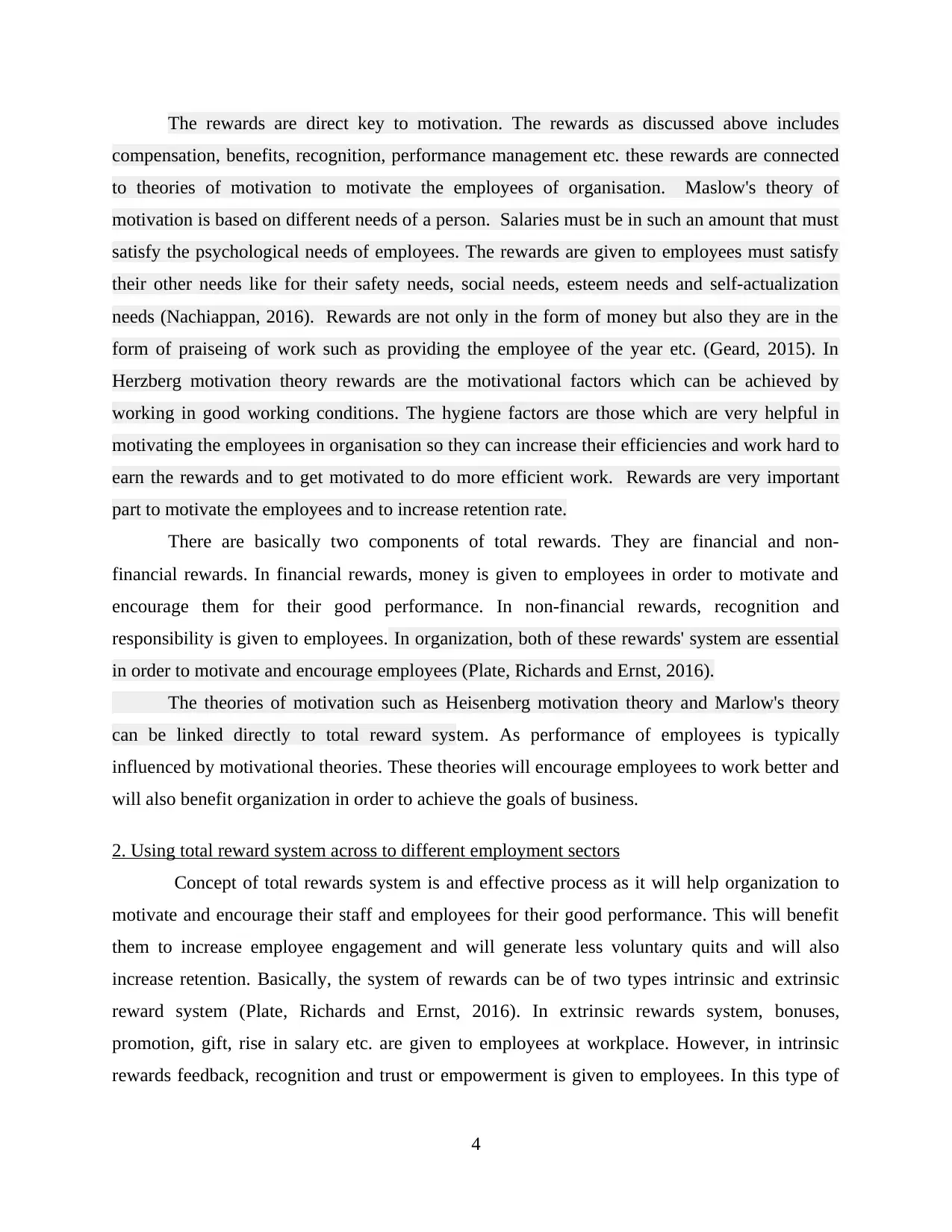
The rewards are direct key to motivation. The rewards as discussed above includes
compensation, benefits, recognition, performance management etc. these rewards are connected
to theories of motivation to motivate the employees of organisation. Maslow's theory of
motivation is based on different needs of a person. Salaries must be in such an amount that must
satisfy the psychological needs of employees. The rewards are given to employees must satisfy
their other needs like for their safety needs, social needs, esteem needs and self-actualization
needs (Nachiappan, 2016). Rewards are not only in the form of money but also they are in the
form of praiseing of work such as providing the employee of the year etc. (Geard, 2015). In
Herzberg motivation theory rewards are the motivational factors which can be achieved by
working in good working conditions. The hygiene factors are those which are very helpful in
motivating the employees in organisation so they can increase their efficiencies and work hard to
earn the rewards and to get motivated to do more efficient work. Rewards are very important
part to motivate the employees and to increase retention rate.
There are basically two components of total rewards. They are financial and non-
financial rewards. In financial rewards, money is given to employees in order to motivate and
encourage them for their good performance. In non-financial rewards, recognition and
responsibility is given to employees. In organization, both of these rewards' system are essential
in order to motivate and encourage employees (Plate, Richards and Ernst, 2016).
The theories of motivation such as Heisenberg motivation theory and Marlow's theory
can be linked directly to total reward system. As performance of employees is typically
influenced by motivational theories. These theories will encourage employees to work better and
will also benefit organization in order to achieve the goals of business.
2. Using total reward system across to different employment sectors
Concept of total rewards system is and effective process as it will help organization to
motivate and encourage their staff and employees for their good performance. This will benefit
them to increase employee engagement and will generate less voluntary quits and will also
increase retention. Basically, the system of rewards can be of two types intrinsic and extrinsic
reward system (Plate, Richards and Ernst, 2016). In extrinsic rewards system, bonuses,
promotion, gift, rise in salary etc. are given to employees at workplace. However, in intrinsic
rewards feedback, recognition and trust or empowerment is given to employees. In this type of
4
compensation, benefits, recognition, performance management etc. these rewards are connected
to theories of motivation to motivate the employees of organisation. Maslow's theory of
motivation is based on different needs of a person. Salaries must be in such an amount that must
satisfy the psychological needs of employees. The rewards are given to employees must satisfy
their other needs like for their safety needs, social needs, esteem needs and self-actualization
needs (Nachiappan, 2016). Rewards are not only in the form of money but also they are in the
form of praiseing of work such as providing the employee of the year etc. (Geard, 2015). In
Herzberg motivation theory rewards are the motivational factors which can be achieved by
working in good working conditions. The hygiene factors are those which are very helpful in
motivating the employees in organisation so they can increase their efficiencies and work hard to
earn the rewards and to get motivated to do more efficient work. Rewards are very important
part to motivate the employees and to increase retention rate.
There are basically two components of total rewards. They are financial and non-
financial rewards. In financial rewards, money is given to employees in order to motivate and
encourage them for their good performance. In non-financial rewards, recognition and
responsibility is given to employees. In organization, both of these rewards' system are essential
in order to motivate and encourage employees (Plate, Richards and Ernst, 2016).
The theories of motivation such as Heisenberg motivation theory and Marlow's theory
can be linked directly to total reward system. As performance of employees is typically
influenced by motivational theories. These theories will encourage employees to work better and
will also benefit organization in order to achieve the goals of business.
2. Using total reward system across to different employment sectors
Concept of total rewards system is and effective process as it will help organization to
motivate and encourage their staff and employees for their good performance. This will benefit
them to increase employee engagement and will generate less voluntary quits and will also
increase retention. Basically, the system of rewards can be of two types intrinsic and extrinsic
reward system (Plate, Richards and Ernst, 2016). In extrinsic rewards system, bonuses,
promotion, gift, rise in salary etc. are given to employees at workplace. However, in intrinsic
rewards feedback, recognition and trust or empowerment is given to employees. In this type of
4
⊘ This is a preview!⊘
Do you want full access?
Subscribe today to unlock all pages.

Trusted by 1+ million students worldwide
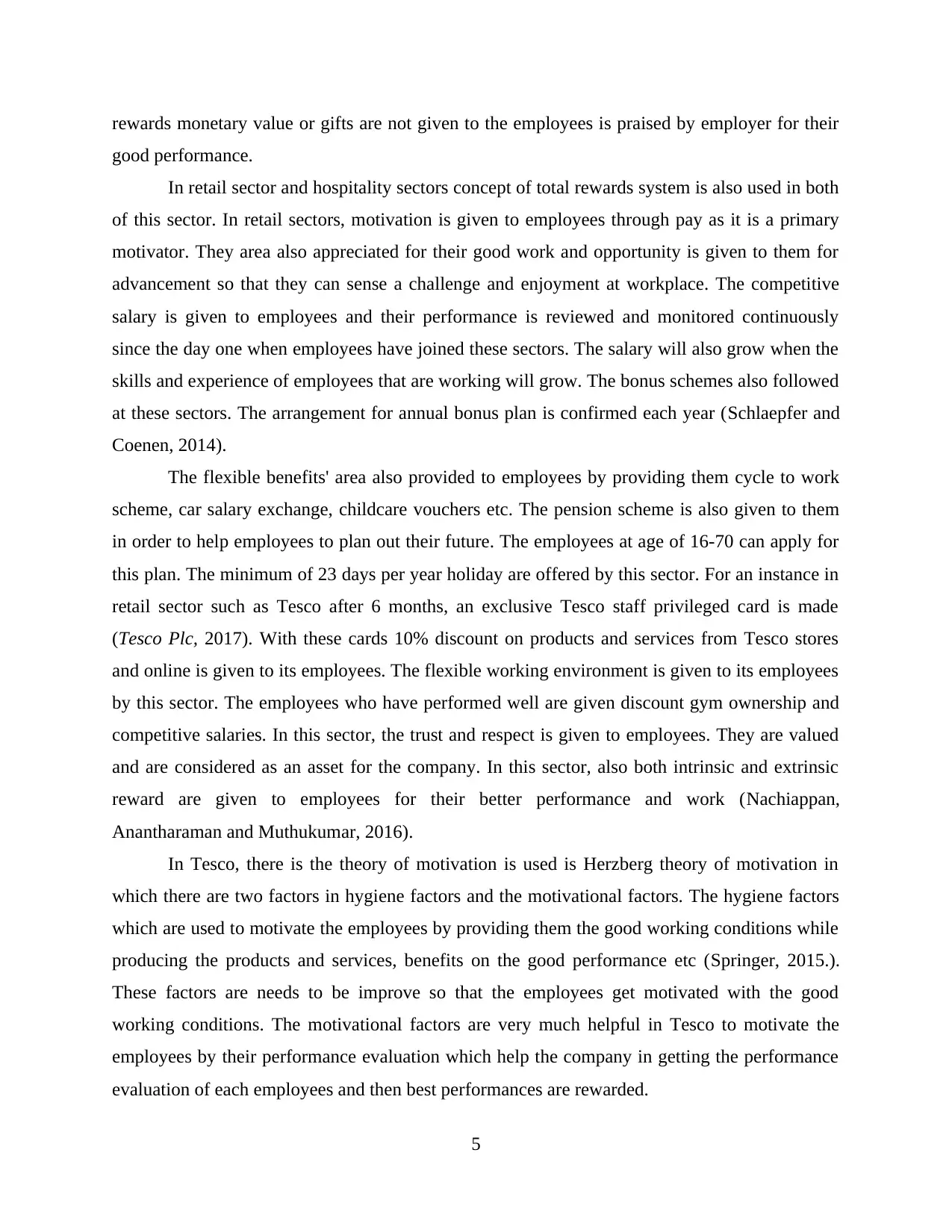
rewards monetary value or gifts are not given to the employees is praised by employer for their
good performance.
In retail sector and hospitality sectors concept of total rewards system is also used in both
of this sector. In retail sectors, motivation is given to employees through pay as it is a primary
motivator. They area also appreciated for their good work and opportunity is given to them for
advancement so that they can sense a challenge and enjoyment at workplace. The competitive
salary is given to employees and their performance is reviewed and monitored continuously
since the day one when employees have joined these sectors. The salary will also grow when the
skills and experience of employees that are working will grow. The bonus schemes also followed
at these sectors. The arrangement for annual bonus plan is confirmed each year (Schlaepfer and
Coenen, 2014).
The flexible benefits' area also provided to employees by providing them cycle to work
scheme, car salary exchange, childcare vouchers etc. The pension scheme is also given to them
in order to help employees to plan out their future. The employees at age of 16-70 can apply for
this plan. The minimum of 23 days per year holiday are offered by this sector. For an instance in
retail sector such as Tesco after 6 months, an exclusive Tesco staff privileged card is made
(Tesco Plc, 2017). With these cards 10% discount on products and services from Tesco stores
and online is given to its employees. The flexible working environment is given to its employees
by this sector. The employees who have performed well are given discount gym ownership and
competitive salaries. In this sector, the trust and respect is given to employees. They are valued
and are considered as an asset for the company. In this sector, also both intrinsic and extrinsic
reward are given to employees for their better performance and work (Nachiappan,
Anantharaman and Muthukumar, 2016).
In Tesco, there is the theory of motivation is used is Herzberg theory of motivation in
which there are two factors in hygiene factors and the motivational factors. The hygiene factors
which are used to motivate the employees by providing them the good working conditions while
producing the products and services, benefits on the good performance etc (Springer, 2015.).
These factors are needs to be improve so that the employees get motivated with the good
working conditions. The motivational factors are very much helpful in Tesco to motivate the
employees by their performance evaluation which help the company in getting the performance
evaluation of each employees and then best performances are rewarded.
5
good performance.
In retail sector and hospitality sectors concept of total rewards system is also used in both
of this sector. In retail sectors, motivation is given to employees through pay as it is a primary
motivator. They area also appreciated for their good work and opportunity is given to them for
advancement so that they can sense a challenge and enjoyment at workplace. The competitive
salary is given to employees and their performance is reviewed and monitored continuously
since the day one when employees have joined these sectors. The salary will also grow when the
skills and experience of employees that are working will grow. The bonus schemes also followed
at these sectors. The arrangement for annual bonus plan is confirmed each year (Schlaepfer and
Coenen, 2014).
The flexible benefits' area also provided to employees by providing them cycle to work
scheme, car salary exchange, childcare vouchers etc. The pension scheme is also given to them
in order to help employees to plan out their future. The employees at age of 16-70 can apply for
this plan. The minimum of 23 days per year holiday are offered by this sector. For an instance in
retail sector such as Tesco after 6 months, an exclusive Tesco staff privileged card is made
(Tesco Plc, 2017). With these cards 10% discount on products and services from Tesco stores
and online is given to its employees. The flexible working environment is given to its employees
by this sector. The employees who have performed well are given discount gym ownership and
competitive salaries. In this sector, the trust and respect is given to employees. They are valued
and are considered as an asset for the company. In this sector, also both intrinsic and extrinsic
reward are given to employees for their better performance and work (Nachiappan,
Anantharaman and Muthukumar, 2016).
In Tesco, there is the theory of motivation is used is Herzberg theory of motivation in
which there are two factors in hygiene factors and the motivational factors. The hygiene factors
which are used to motivate the employees by providing them the good working conditions while
producing the products and services, benefits on the good performance etc (Springer, 2015.).
These factors are needs to be improve so that the employees get motivated with the good
working conditions. The motivational factors are very much helpful in Tesco to motivate the
employees by their performance evaluation which help the company in getting the performance
evaluation of each employees and then best performances are rewarded.
5
Paraphrase This Document
Need a fresh take? Get an instant paraphrase of this document with our AI Paraphraser
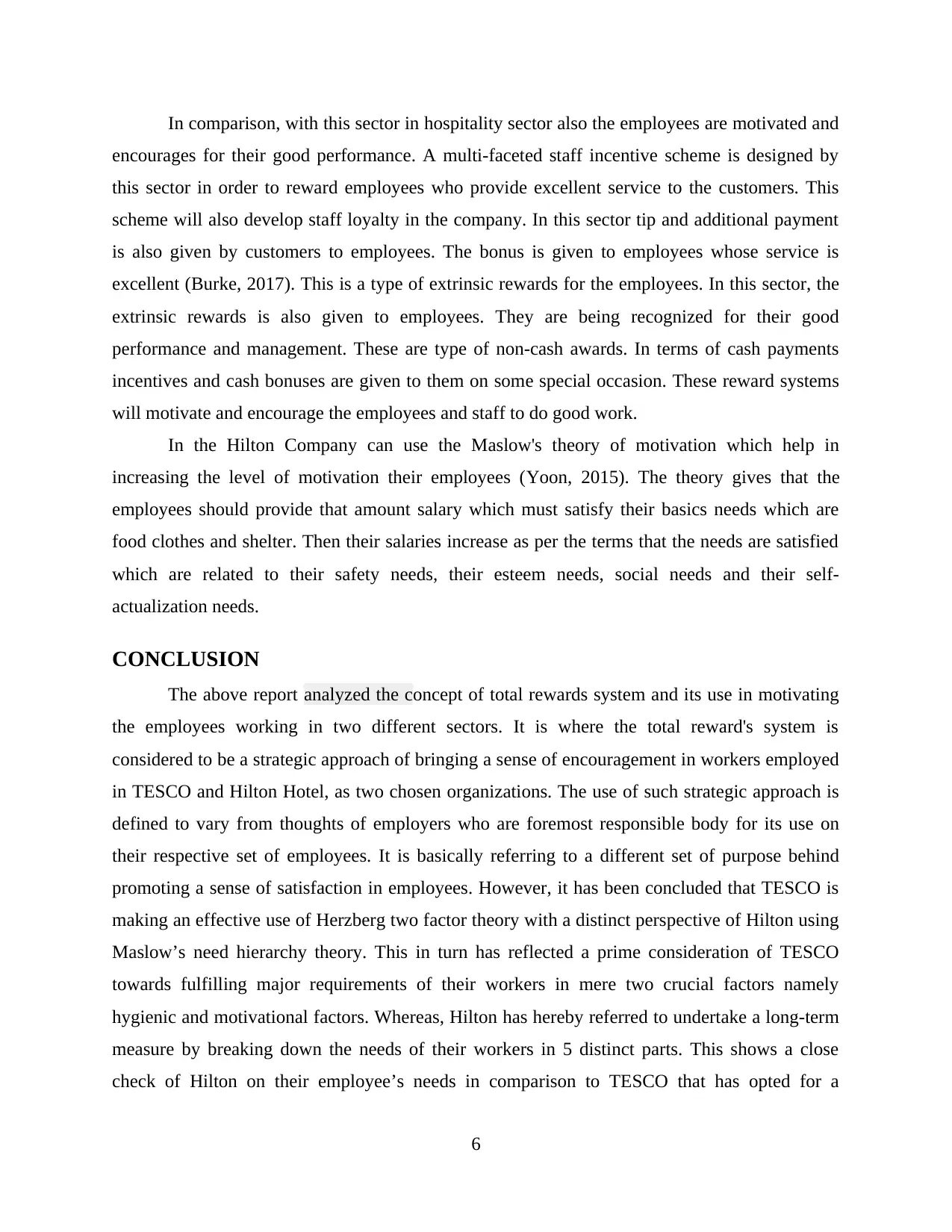
In comparison, with this sector in hospitality sector also the employees are motivated and
encourages for their good performance. A multi-faceted staff incentive scheme is designed by
this sector in order to reward employees who provide excellent service to the customers. This
scheme will also develop staff loyalty in the company. In this sector tip and additional payment
is also given by customers to employees. The bonus is given to employees whose service is
excellent (Burke, 2017). This is a type of extrinsic rewards for the employees. In this sector, the
extrinsic rewards is also given to employees. They are being recognized for their good
performance and management. These are type of non-cash awards. In terms of cash payments
incentives and cash bonuses are given to them on some special occasion. These reward systems
will motivate and encourage the employees and staff to do good work.
In the Hilton Company can use the Maslow's theory of motivation which help in
increasing the level of motivation their employees (Yoon, 2015). The theory gives that the
employees should provide that amount salary which must satisfy their basics needs which are
food clothes and shelter. Then their salaries increase as per the terms that the needs are satisfied
which are related to their safety needs, their esteem needs, social needs and their self-
actualization needs.
CONCLUSION
The above report analyzed the concept of total rewards system and its use in motivating
the employees working in two different sectors. It is where the total reward's system is
considered to be a strategic approach of bringing a sense of encouragement in workers employed
in TESCO and Hilton Hotel, as two chosen organizations. The use of such strategic approach is
defined to vary from thoughts of employers who are foremost responsible body for its use on
their respective set of employees. It is basically referring to a different set of purpose behind
promoting a sense of satisfaction in employees. However, it has been concluded that TESCO is
making an effective use of Herzberg two factor theory with a distinct perspective of Hilton using
Maslow’s need hierarchy theory. This in turn has reflected a prime consideration of TESCO
towards fulfilling major requirements of their workers in mere two crucial factors namely
hygienic and motivational factors. Whereas, Hilton has hereby referred to undertake a long-term
measure by breaking down the needs of their workers in 5 distinct parts. This shows a close
check of Hilton on their employee’s needs in comparison to TESCO that has opted for a
6
encourages for their good performance. A multi-faceted staff incentive scheme is designed by
this sector in order to reward employees who provide excellent service to the customers. This
scheme will also develop staff loyalty in the company. In this sector tip and additional payment
is also given by customers to employees. The bonus is given to employees whose service is
excellent (Burke, 2017). This is a type of extrinsic rewards for the employees. In this sector, the
extrinsic rewards is also given to employees. They are being recognized for their good
performance and management. These are type of non-cash awards. In terms of cash payments
incentives and cash bonuses are given to them on some special occasion. These reward systems
will motivate and encourage the employees and staff to do good work.
In the Hilton Company can use the Maslow's theory of motivation which help in
increasing the level of motivation their employees (Yoon, 2015). The theory gives that the
employees should provide that amount salary which must satisfy their basics needs which are
food clothes and shelter. Then their salaries increase as per the terms that the needs are satisfied
which are related to their safety needs, their esteem needs, social needs and their self-
actualization needs.
CONCLUSION
The above report analyzed the concept of total rewards system and its use in motivating
the employees working in two different sectors. It is where the total reward's system is
considered to be a strategic approach of bringing a sense of encouragement in workers employed
in TESCO and Hilton Hotel, as two chosen organizations. The use of such strategic approach is
defined to vary from thoughts of employers who are foremost responsible body for its use on
their respective set of employees. It is basically referring to a different set of purpose behind
promoting a sense of satisfaction in employees. However, it has been concluded that TESCO is
making an effective use of Herzberg two factor theory with a distinct perspective of Hilton using
Maslow’s need hierarchy theory. This in turn has reflected a prime consideration of TESCO
towards fulfilling major requirements of their workers in mere two crucial factors namely
hygienic and motivational factors. Whereas, Hilton has hereby referred to undertake a long-term
measure by breaking down the needs of their workers in 5 distinct parts. This shows a close
check of Hilton on their employee’s needs in comparison to TESCO that has opted for a
6
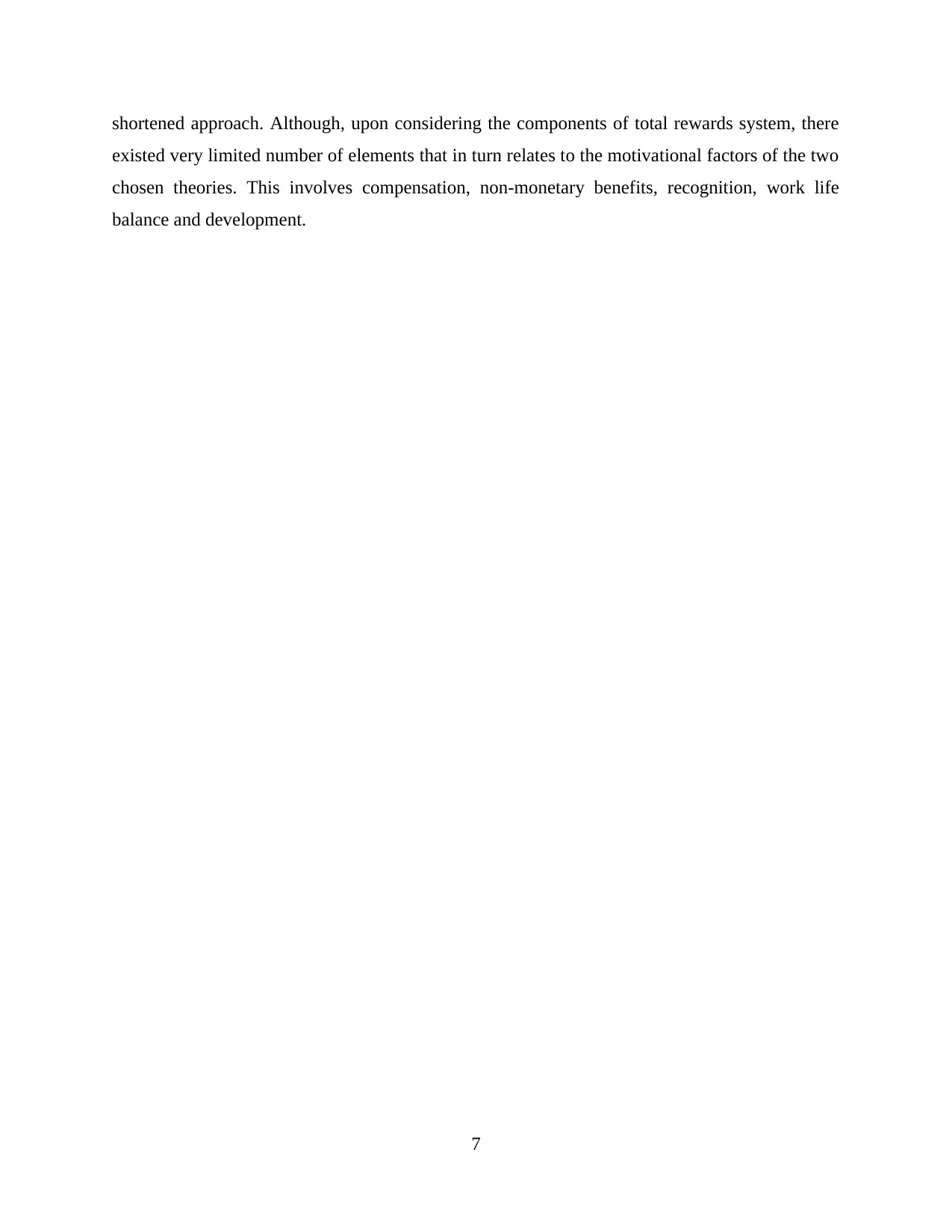
shortened approach. Although, upon considering the components of total rewards system, there
existed very limited number of elements that in turn relates to the motivational factors of the two
chosen theories. This involves compensation, non-monetary benefits, recognition, work life
balance and development.
7
existed very limited number of elements that in turn relates to the motivational factors of the two
chosen theories. This involves compensation, non-monetary benefits, recognition, work life
balance and development.
7
⊘ This is a preview!⊘
Do you want full access?
Subscribe today to unlock all pages.

Trusted by 1+ million students worldwide
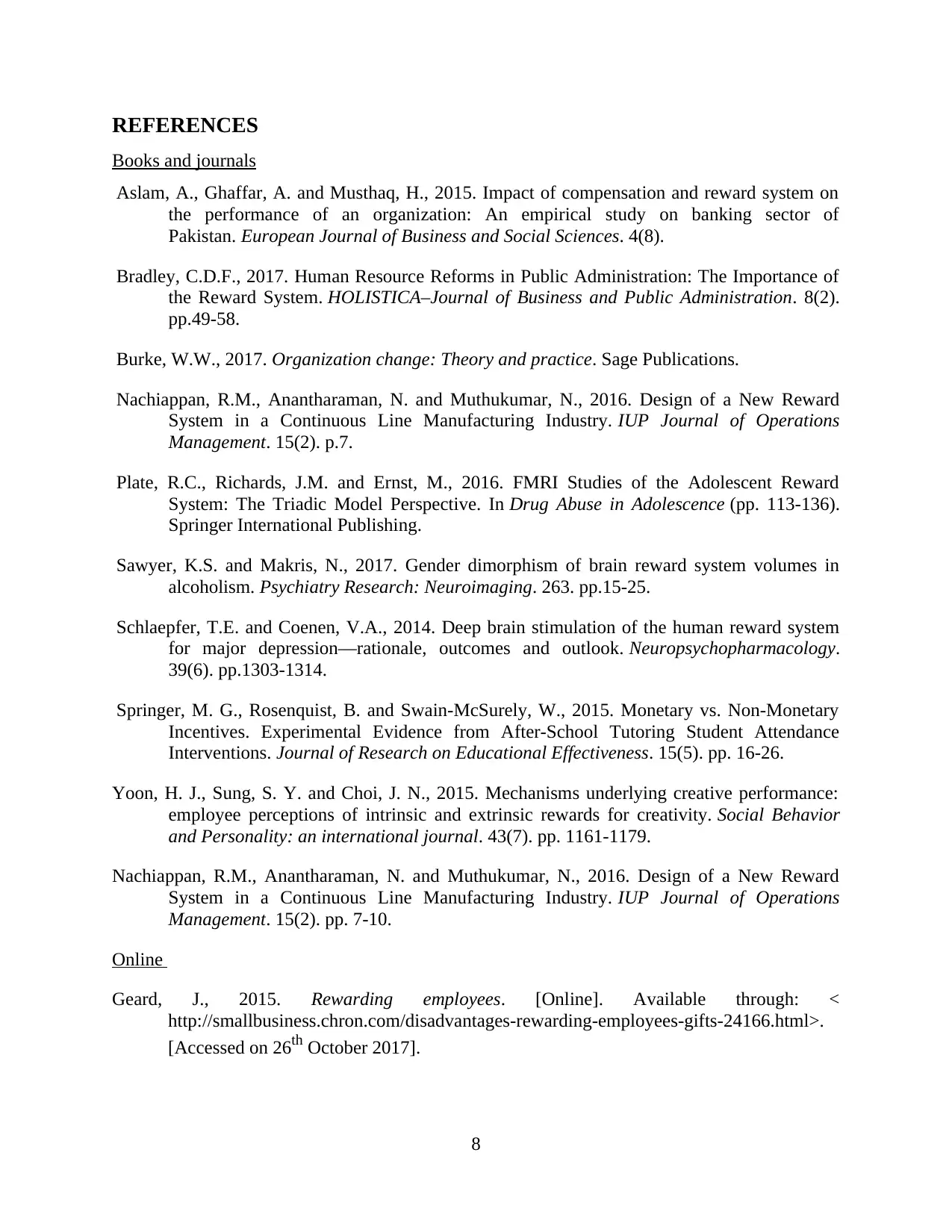
REFERENCES
Books and journals
Aslam, A., Ghaffar, A. and Musthaq, H., 2015. Impact of compensation and reward system on
the performance of an organization: An empirical study on banking sector of
Pakistan. European Journal of Business and Social Sciences. 4(8).
Bradley, C.D.F., 2017. Human Resource Reforms in Public Administration: The Importance of
the Reward System. HOLISTICA–Journal of Business and Public Administration. 8(2).
pp.49-58.
Burke, W.W., 2017. Organization change: Theory and practice. Sage Publications.
Nachiappan, R.M., Anantharaman, N. and Muthukumar, N., 2016. Design of a New Reward
System in a Continuous Line Manufacturing Industry. IUP Journal of Operations
Management. 15(2). p.7.
Plate, R.C., Richards, J.M. and Ernst, M., 2016. FMRI Studies of the Adolescent Reward
System: The Triadic Model Perspective. In Drug Abuse in Adolescence (pp. 113-136).
Springer International Publishing.
Sawyer, K.S. and Makris, N., 2017. Gender dimorphism of brain reward system volumes in
alcoholism. Psychiatry Research: Neuroimaging. 263. pp.15-25.
Schlaepfer, T.E. and Coenen, V.A., 2014. Deep brain stimulation of the human reward system
for major depression—rationale, outcomes and outlook. Neuropsychopharmacology.
39(6). pp.1303-1314.
Springer, M. G., Rosenquist, B. and Swain-McSurely, W., 2015. Monetary vs. Non-Monetary
Incentives. Experimental Evidence from After-School Tutoring Student Attendance
Interventions. Journal of Research on Educational Effectiveness. 15(5). pp. 16-26.
Yoon, H. J., Sung, S. Y. and Choi, J. N., 2015. Mechanisms underlying creative performance:
employee perceptions of intrinsic and extrinsic rewards for creativity. Social Behavior
and Personality: an international journal. 43(7). pp. 1161-1179.
Nachiappan, R.M., Anantharaman, N. and Muthukumar, N., 2016. Design of a New Reward
System in a Continuous Line Manufacturing Industry. IUP Journal of Operations
Management. 15(2). pp. 7-10.
Online
Geard, J., 2015. Rewarding employees. [Online]. Available through: <
http://smallbusiness.chron.com/disadvantages-rewarding-employees-gifts-24166.html>.
[Accessed on 26th October 2017].
8
Books and journals
Aslam, A., Ghaffar, A. and Musthaq, H., 2015. Impact of compensation and reward system on
the performance of an organization: An empirical study on banking sector of
Pakistan. European Journal of Business and Social Sciences. 4(8).
Bradley, C.D.F., 2017. Human Resource Reforms in Public Administration: The Importance of
the Reward System. HOLISTICA–Journal of Business and Public Administration. 8(2).
pp.49-58.
Burke, W.W., 2017. Organization change: Theory and practice. Sage Publications.
Nachiappan, R.M., Anantharaman, N. and Muthukumar, N., 2016. Design of a New Reward
System in a Continuous Line Manufacturing Industry. IUP Journal of Operations
Management. 15(2). p.7.
Plate, R.C., Richards, J.M. and Ernst, M., 2016. FMRI Studies of the Adolescent Reward
System: The Triadic Model Perspective. In Drug Abuse in Adolescence (pp. 113-136).
Springer International Publishing.
Sawyer, K.S. and Makris, N., 2017. Gender dimorphism of brain reward system volumes in
alcoholism. Psychiatry Research: Neuroimaging. 263. pp.15-25.
Schlaepfer, T.E. and Coenen, V.A., 2014. Deep brain stimulation of the human reward system
for major depression—rationale, outcomes and outlook. Neuropsychopharmacology.
39(6). pp.1303-1314.
Springer, M. G., Rosenquist, B. and Swain-McSurely, W., 2015. Monetary vs. Non-Monetary
Incentives. Experimental Evidence from After-School Tutoring Student Attendance
Interventions. Journal of Research on Educational Effectiveness. 15(5). pp. 16-26.
Yoon, H. J., Sung, S. Y. and Choi, J. N., 2015. Mechanisms underlying creative performance:
employee perceptions of intrinsic and extrinsic rewards for creativity. Social Behavior
and Personality: an international journal. 43(7). pp. 1161-1179.
Nachiappan, R.M., Anantharaman, N. and Muthukumar, N., 2016. Design of a New Reward
System in a Continuous Line Manufacturing Industry. IUP Journal of Operations
Management. 15(2). pp. 7-10.
Online
Geard, J., 2015. Rewarding employees. [Online]. Available through: <
http://smallbusiness.chron.com/disadvantages-rewarding-employees-gifts-24166.html>.
[Accessed on 26th October 2017].
8
Paraphrase This Document
Need a fresh take? Get an instant paraphrase of this document with our AI Paraphraser
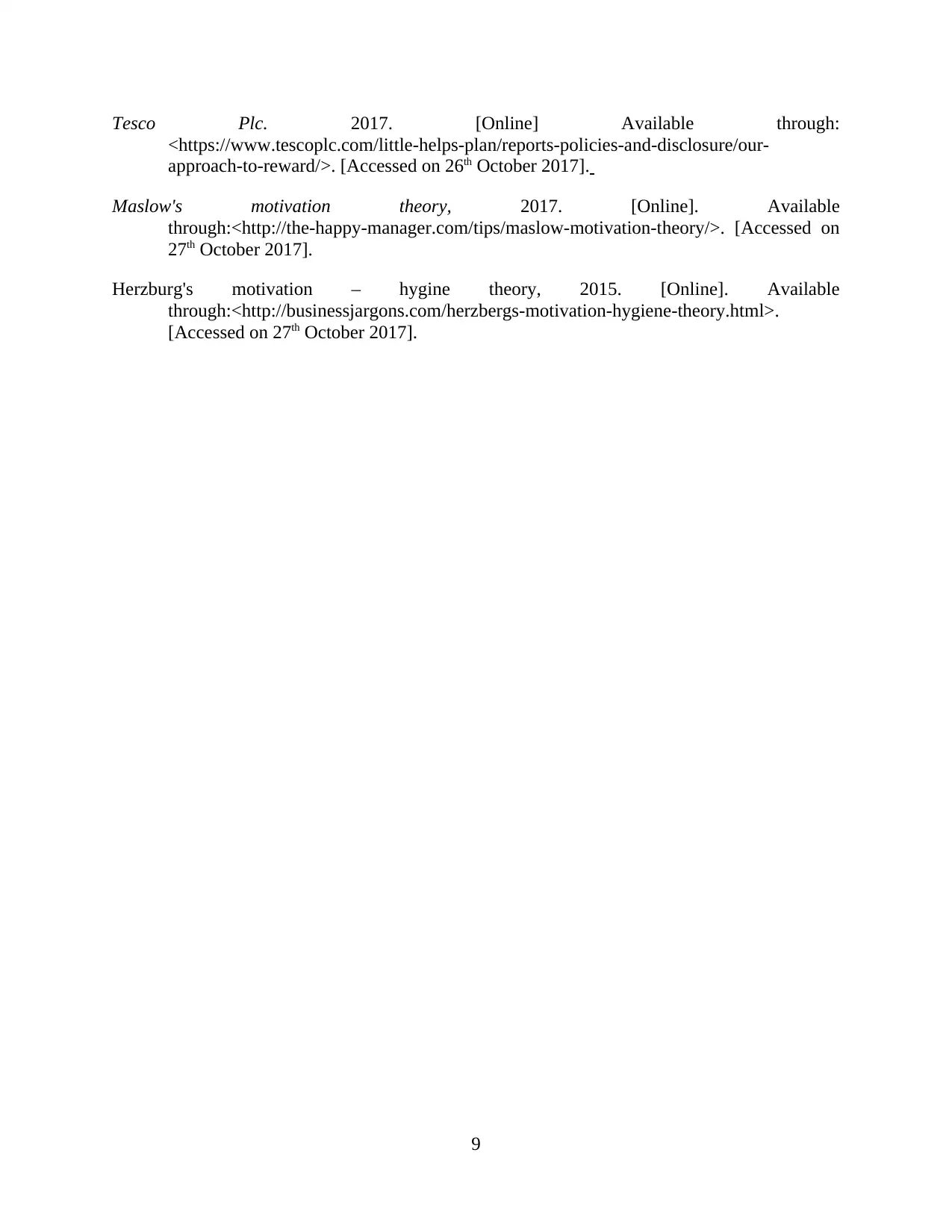
Tesco Plc. 2017. [Online] Available through:
<https://www.tescoplc.com/little-helps-plan/reports-policies-and-disclosure/our-
approach-to-reward/>. [Accessed on 26th October 2017].
Maslow's motivation theory, 2017. [Online]. Available
through:<http://the-happy-manager.com/tips/maslow-motivation-theory/>. [Accessed on
27th October 2017].
Herzburg's motivation – hygine theory, 2015. [Online]. Available
through:<http://businessjargons.com/herzbergs-motivation-hygiene-theory.html>.
[Accessed on 27th October 2017].
9
<https://www.tescoplc.com/little-helps-plan/reports-policies-and-disclosure/our-
approach-to-reward/>. [Accessed on 26th October 2017].
Maslow's motivation theory, 2017. [Online]. Available
through:<http://the-happy-manager.com/tips/maslow-motivation-theory/>. [Accessed on
27th October 2017].
Herzburg's motivation – hygine theory, 2015. [Online]. Available
through:<http://businessjargons.com/herzbergs-motivation-hygiene-theory.html>.
[Accessed on 27th October 2017].
9
1 out of 11
Related Documents
Your All-in-One AI-Powered Toolkit for Academic Success.
+13062052269
info@desklib.com
Available 24*7 on WhatsApp / Email
![[object Object]](/_next/static/media/star-bottom.7253800d.svg)
Unlock your academic potential
Copyright © 2020–2025 A2Z Services. All Rights Reserved. Developed and managed by ZUCOL.




